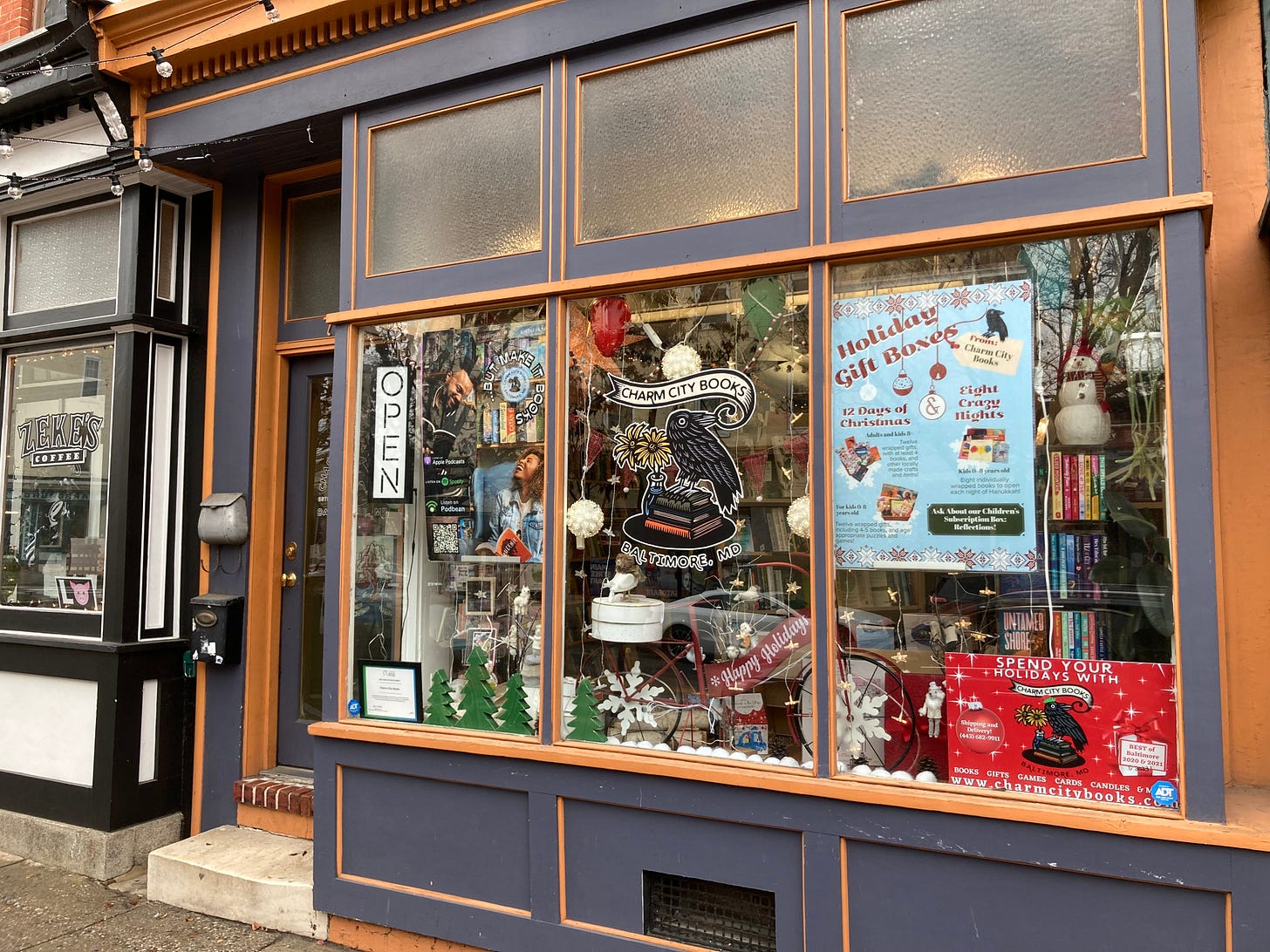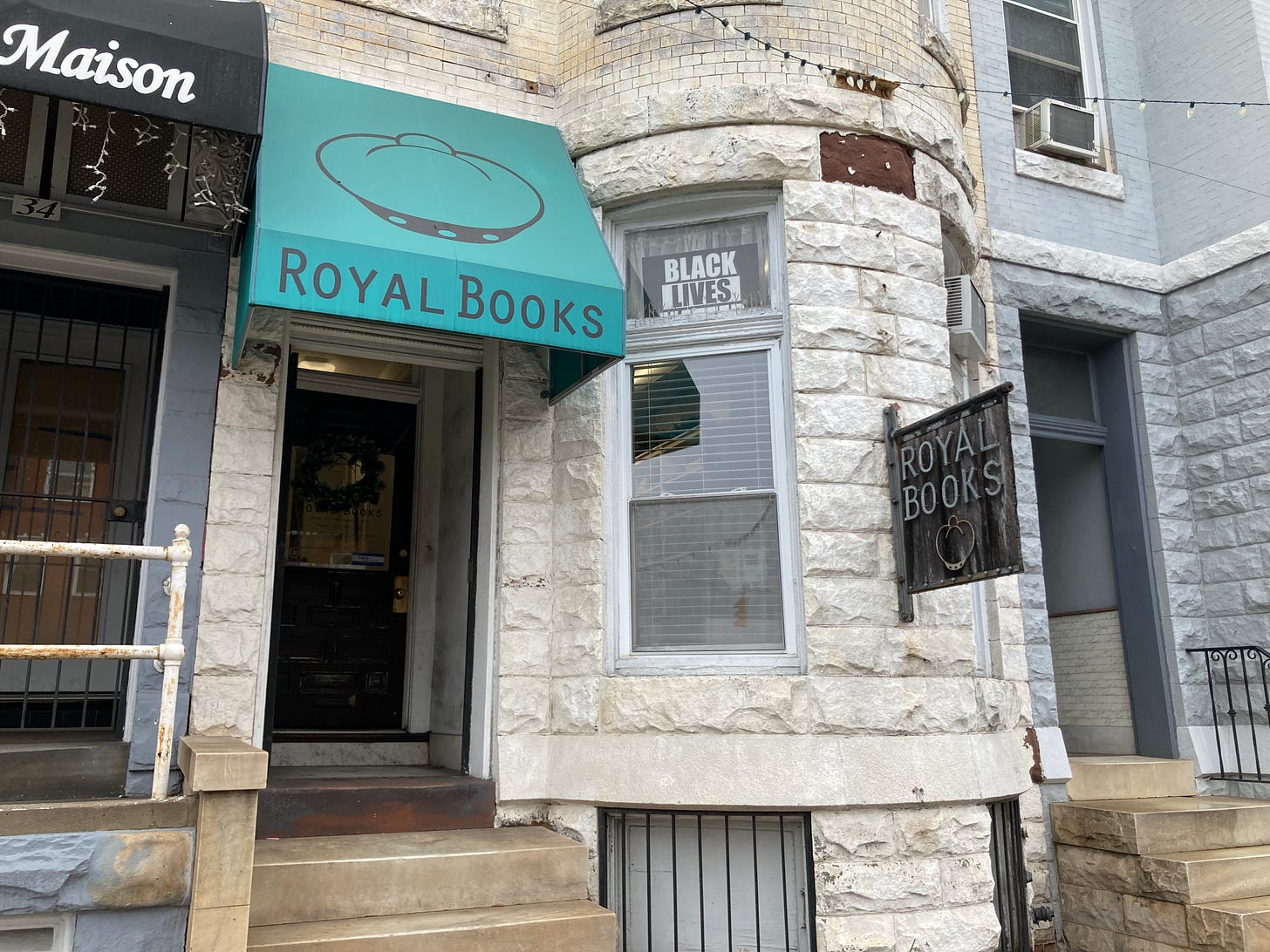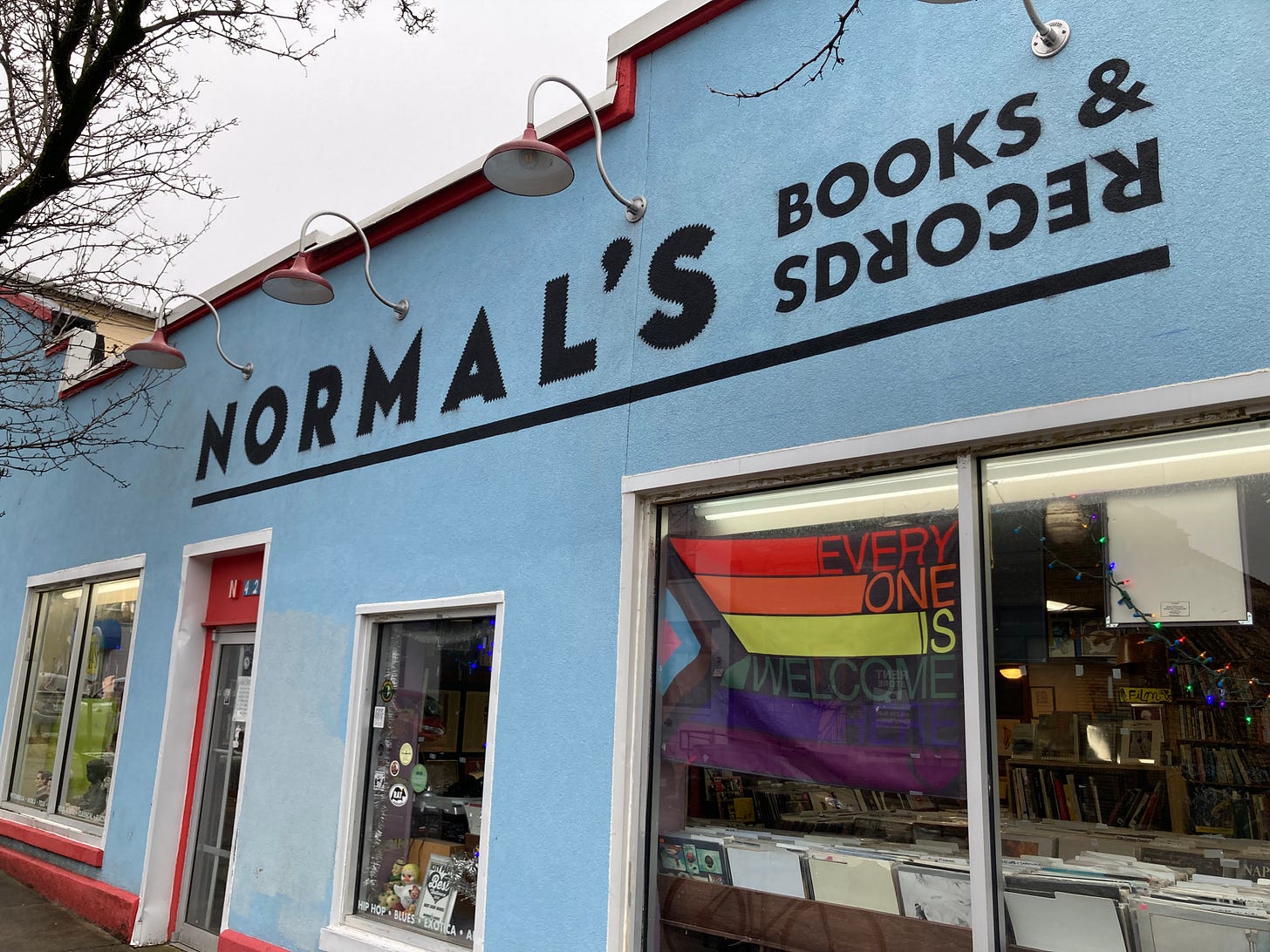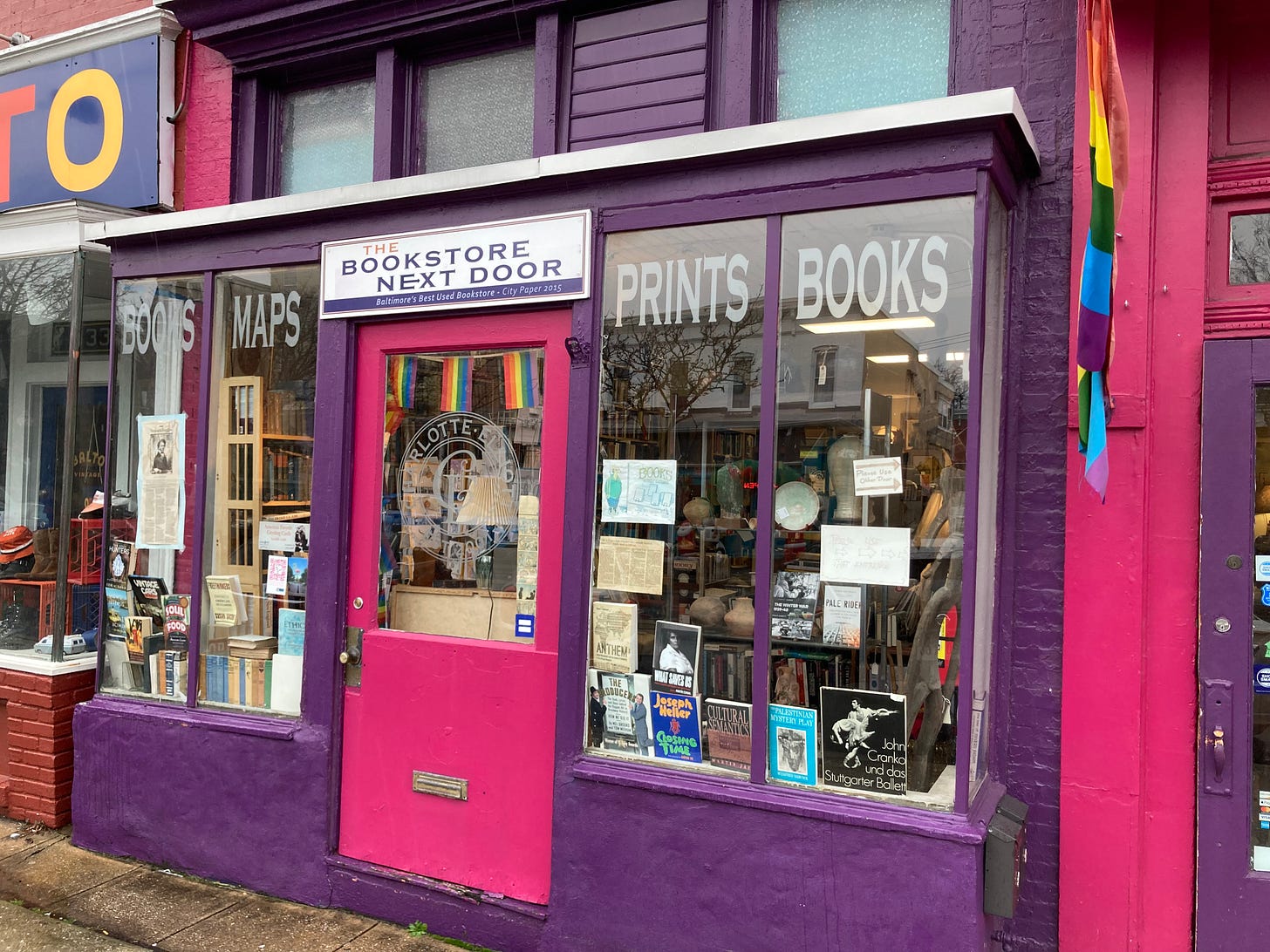D.C. Field Notes #5: A Field Trip to Baltimore
Exploring the character of the city through it's bookstores
“Baltimore is warm but pleasant... I belong here, where everything is civilized and gay and rotted and polite.”
― F. Scott Fitzgerald
It certainly was warm the first time I went to Baltimore in the summer of 2019. I’ve been back many times since in varying weather, but found Fitzgerald’s quote to be eerily accurate all these years later. It is a civilized, distinguished city; rotted in parts, yes, but in a way that adds to the enigma that is Maryland’s largest city.
One key to appreciating Baltimore is to accept all of its parts. The harbour, the row houses both charming and vacant, the gritty streets and architectural variety. No city I’ve visited has quite as much character as Baltimore.
Once my wife and I had two kids, it took a little more effort to load everyone up and drive the hour north to Baltimore to explore a new neighborhood. We had visited a handful of bookstores on past trips, but I knew that it would take far too long to visit them all at this new pace.
So, with just one child in tow, the toddler, we set out on a cold winter morning with the goal of visiting as many bookstores as we could until our patience ran out (we ended up visiting six).
Visiting bookstores is a great way to explore different neighborhoods, and Baltimore is small enough that with a little planning, we could crisscross town in just a few hours.
Our first stop was Pig Town, a historic neighborhood southwest of the downtown and only a few blocks from Camden Yards. Speaking of baseball, it’s also where Babe Ruth was born and raised. I’m a sucker for a good logo, and Charm City Books has one of the best. The store sells new books, sort of a classic neighborhood shop, and really stood out for its children’s books and play area on the second floor. I let the kid do his thing as I browsed downstairs, spending most of the time reading a few passages from I Love Russia by Elena Kostyuchenko that came out last year.
Our next stop was Charles Village to visit Royal Books. I was unaware that it was open by appointment only, but they seemed to take pity on a rain-soaked father/son duo and let us in.
Royal Books has a deliberate focus on first editions, specifically film and art. While not housed in the physical location, their online store has a huge selection of film artifacts that’s worth looking through on its own. The physical store is fairly sparse. This wasn’t the kind of place to stack books from floor to ceiling. In fact, many shelves were empty. It almost felt a little liminal, like I’d walked into some sort of book time capsule, or a Stanley Kubrick set, where everything was immaculately preserved, a little retro, and interesting enough to generate careful browsing despite the limited selection.
I was most excited to see a first edition of Cormac McCarthy’s The Stonemason. In fact, it’s the only time I’ve ever seen a copy of it in a bookstore. $75 was a little more than I was willing to part with, yet I could appreciate more the purpose of a rare book store like Royal Books after holding it. Bookstores such as this are curators, and by their curation, preserve what’s important in our literary past.
We then crossed town to Lauraville, a sort of sleepy, a New-England-feeling neighborhood on the Northwest. Our destination was Snug Books. It also served as your friendly neighborhood new bookstore, this time with a greater emphasis on young adult and genre fiction. As such, the other shoppers were families with late elementary and early teenage children.
Back into the central part of town, we visited Normals Books and Records. I’d been to Normals before and sort of fell in love. It’s easily within my top ten bookstores of all time, possessing the sort of authentic allure that would almost make it worth moving to the Waverly neighborhood for.
Normals excels for its variety with a strong fiction, classics, biography, history, and music sections. Music is a big part of Normals, and they happened to be playing a dreadful bit of jazz by Albert Ayler called “Truth is Marchin’ In”. I embed it below for your displeasure.
It was at Normal’s that I bought my only book of the day, American Nations by Colin Woodard.
A short jaunt away, we snuck into Greedy Reads. Greedy Reads operates two locations in Baltimore—one in Fells Point and one in Remington. I visited the Remington store, a hard place to miss, thanks to its almost mint paint job around the entire exterior of the building. The browsing experience at Greedy Reads was a little different than other stores I’d been to. For one, the ceilings are very tall but the shelves only go as high as your chest, and the rows are fairly compact. It felt vulnerable, in a way, not the kind of place you could hide in for an hour flipping through books. With a stage at one end, it did seem like the kind of place to host a great event.
Remington itself is a cool neighborhood nestled beneath John Hopkins campus, though it lacks the sort of center street that Pig Town, Waverly, Fells Point, and Hampden showcase.
It was actually to Hampden that we went next for our final bookstore. We almost didn’t make it. The R. House food court across the street from Gready Reads nearly enticed us, though the kid wanted ice cream instead, and after dragging him all over town, I told him we’d get some in Hampden.
Recharged after a shared bowl at the Charmery on the corner of 36th and Chesnut, we arrived at our final store, Charlotte Elliott and The Bookstore Nextdoor. Technically, Charlotte Elliott is the name of the antique store operating out of one half of the shop, and the appropriately named bookstore takes up the other half “nextdoor”.
It’s a bit chaotic inside, loosely organized and packed in tight, but the kind of place you could find a hidden gem. Alas, the boy was spent, and frankly, so was I.
I can’t say I’d recommend visiting six bookstores in a day. Doing so does expose you to a city in an enlightening way, painting a fuller picture of its character, neighborhoods, and geography.










